classification-QM-gutenberg
Introduction
This is a Distant Reader "study carrel", a set of structured data intended to help the student, researcher, or scholar use & understand a corpus.
This study carrel was created on 2021-05-28 by Eric Morgan <emorgan@nd.edu>. The carrel was created using the Distant Reader gutenberg process, and the input was the result of a query applied to a local mirror of Project Gutenberg -- classification:"QM". Then, for future reference, the results were saved to a Zip file complete with rudimentary bibliographics. The name of the file is input-file.zip. The Zip file was then unpacked and the contents saved to a cache as well as a directory of plain text files. All of the analysis -- "reading" -- has been done against these plain text files. For example, a short narrative report has been created. This Web page is a more verbose version of that report.
All study carrels are self-contained -- no Internet connection is necessary to use them. Download this carrel for offline reading. The carrel is made up of many subdirectories and data files. The manifest describes each one in greater detail.
Size
There are 4 item(s) in this carrel, and this carrel is 133,373 words long. Each item in your study carrel is, on average, 44,457 words long. If you dig deeper, then you might want to save yourself some time by reading a shorter item. On the other hand, if your desire is for more detail, then you might consider reading a longer item. The following charts illustrate the overall size of the carrel.
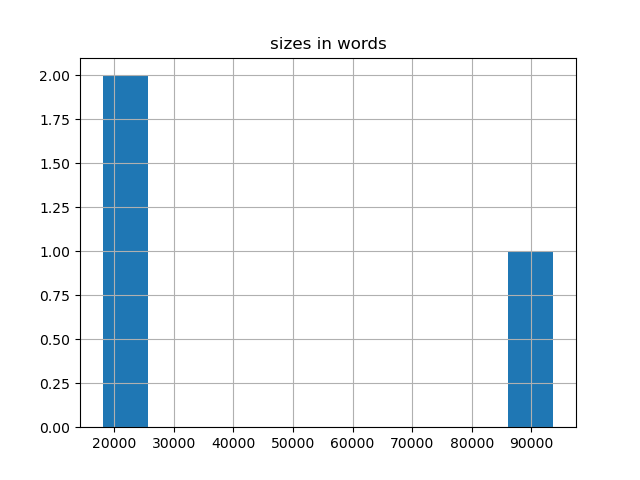
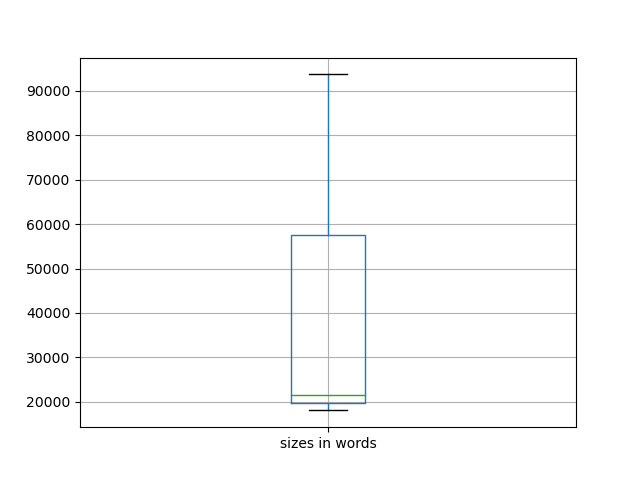
Readability
On a scale from 0 to 100, where 0 is very difficult and 100 is very easy, the documents have an average readability score of 60. Consequently, if you want to read something more simplistic, then consider a document with a higher score. If you want something more specialized, then consider something with a lower score. The following charts illustrate the overall readability of the carrel.
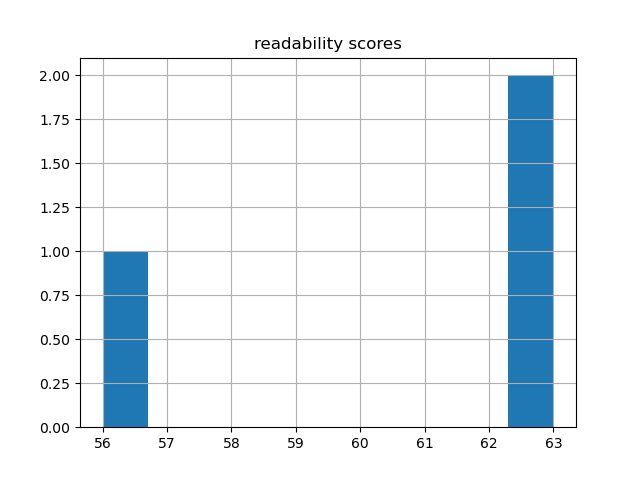
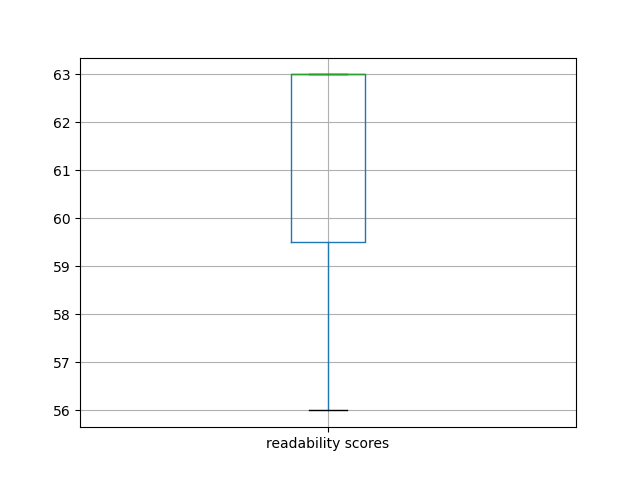
Word Frequencies
By merely counting & tabulating the frequency of individual words or phrases, you can begin to get an understanding of the carrel's "aboutness". Excluding "stop words", some of the more frequent words include:
may, one, development, degeneracy, two, fig, life, cells, first, brain, teeth, great, man, germ, will, children, must, body, embryo, nervous, found, part, often, disease, cases, type, many, illustration, human, mental, case, individual, even, form, certain, lower, also, conditions, less, three, time, much, face, general, like, among, without, new, well, result
Using the three most frequent words, the three files containing all of those words the most are Degeneracy: Its Causes, Signs and Results, Embryology: The Beginnings of Life, and Use of the Dead to the Living.
The most frequent two-word phrases (bigrams) include:
nervous system, per cent, spinal cord, new york, united states, lower jaw, nervous exhaustion, cleft palate, takes place, fertilised ovum, school strain, one side, upper jaw, give rise, take place, human embryo, least resistance, great britain, germ plasm, arrested development, children born, gives rise, havelock ellis, mental science, years ago, next generation, single cell, cerebral hemispheres, dermal bones, acquired characters, alveolar process, embryonic life, mental disease, lower animals, blood supply, yolk sac, one case, american journal, human body, third molars, crown vo, foetal life, new individual, permanent teeth, mucous membrane, hereditary transmission, every one, much less, anthropoid apes, degenerate face
And the three file that use all of the three most frequent phrases are Degeneracy: Its Causes, Signs and Results Embryology: The Beginnings of Life, and Use of the Dead to the Living.
While often deemed superficial or sophomoric, rudimentary frequencies and their associated "word clouds" can be quite insightful:
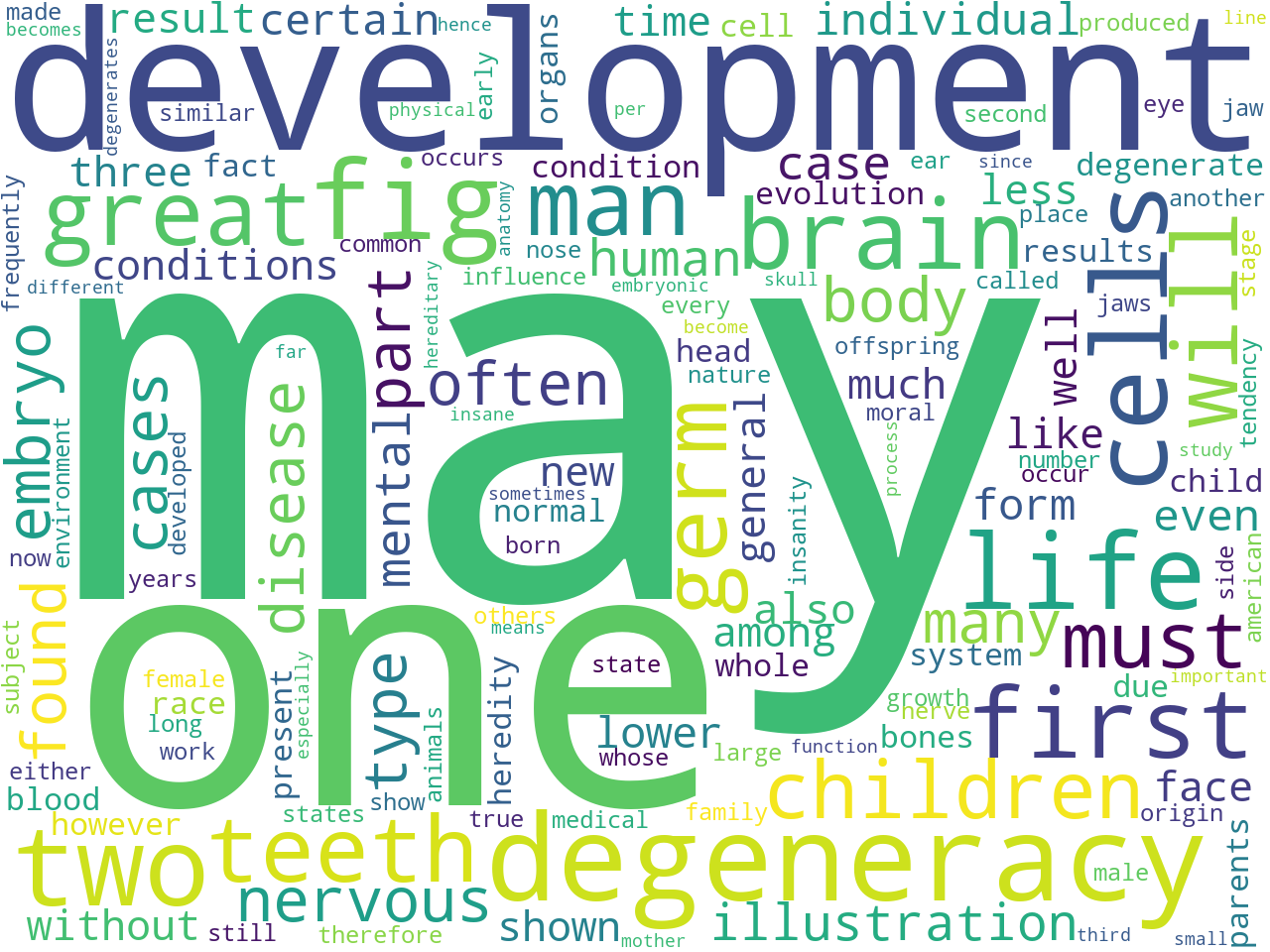
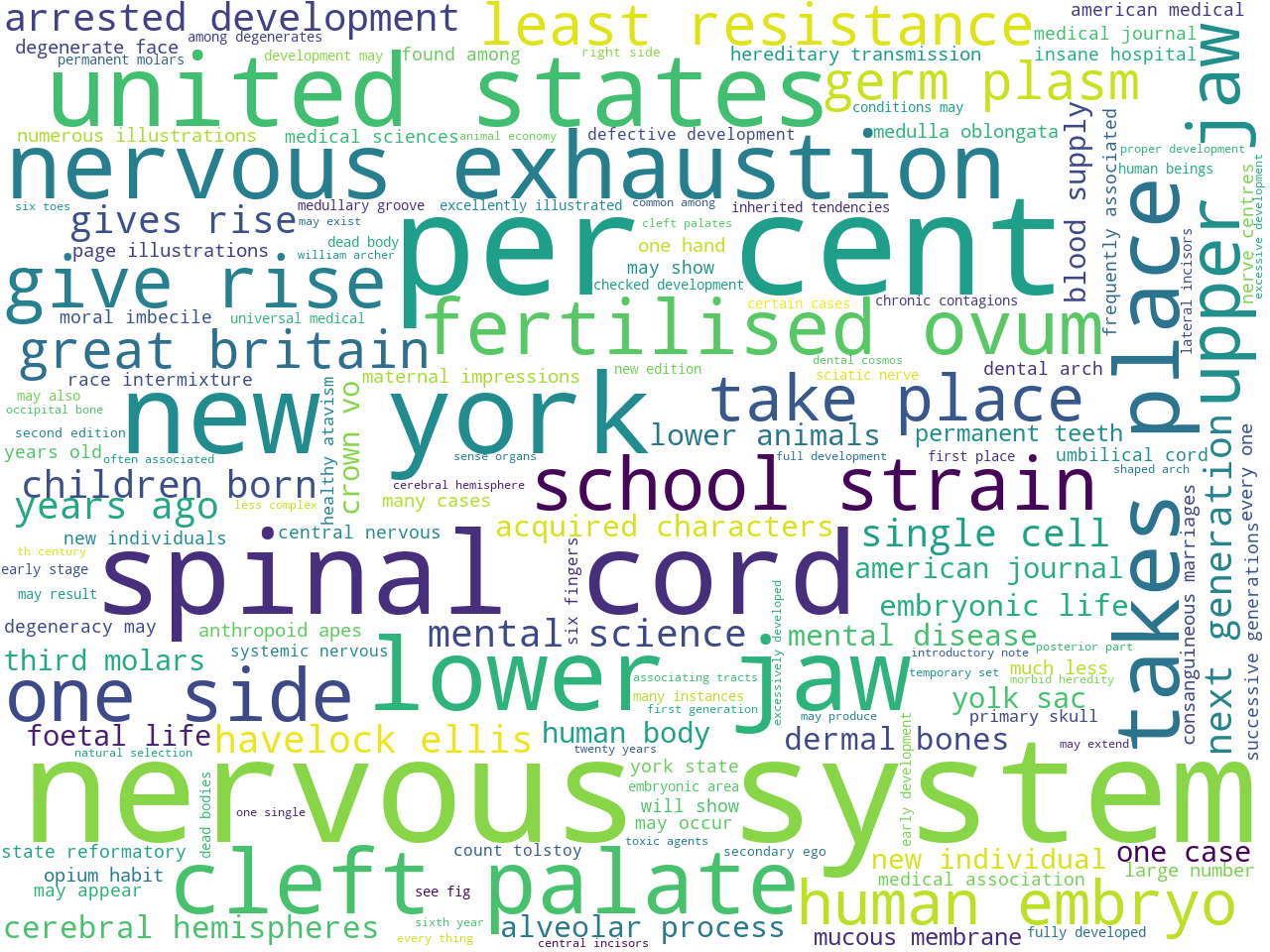
Keywords
Sets of keywords -- statistically significant words -- can be enumerated by comparing the relative frequency of words with the number of times the words appear in an entire corpus. Some of the most statistically significant keywords in the carrel include:
man, development, case, york, united, type, tooth, surgeon, states, spitzka, original, operation, new, morel, mental, medical, life, knowledge, kiernan, journal, insanity, individual, illustration, great, germ, fig, face, embryology, embryo, edinburgh, dr., disease, degeneracy, condition, child, chicago, cell, brain, body, beginning, anatomy, american
And now word clouds really begin to shine:

Topic Modeling
Topic modeling is another popular approach to connoting the aboutness of a corpus. If the study carrel could be summed up in a single word, then that word might be development, and Use of the Dead to the Living is most about that word.
If the study carrel could be summed up in three words ("topics") then those words and their significantly associated titles include:
- degeneracy - Degeneracy: Its Causes, Signs and Results
- cells - Embryology: The Beginnings of Life
- anatomy - Use of the Dead to the Living
If the study carrel could be summed up in five topics, and each topic were each denoted with three words, then those topics and their most significantly associated files would be:
- degeneracy, development, fig - Degeneracy: Its Causes, Signs and Results
- cells, embryo, germ - Embryology: The Beginnings of Life
- anatomy, disease, operation - Use of the Dead to the Living
- earnest, repetition, vague - Surgical Anatomy
- earnest, repetition, vague - Surgical Anatomy
Moreover, the totality of the study carrel's aboutness, can be visualized with the following pie chart:
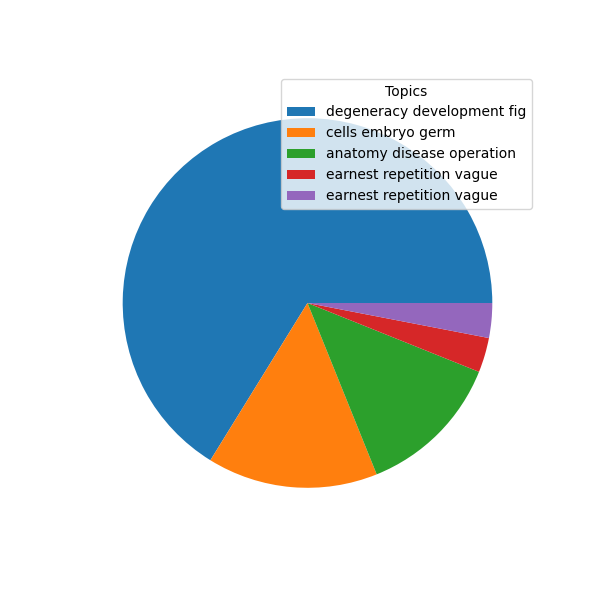
Noun & Verbs
Through an analysis of your study carrel's parts-of-speech, you are able to answer question beyonds aboutness. For example, a list of the most frequent nouns helps you answer what questions; "What is discussed in this collection?":
development, degeneracy, cells, life, brain, children, man, teeth, body, embryo, cases, part, type, illustration, case, disease, germ, conditions, time, face, individual, blood, race, condition, fig, bones, head, system, fact, child, cell, parents, evolution, years, organs, offspring, heredity, side, number, influence, growth, place, others, family, results, tendency, state, eye, stage, jaw
An enumeration of the verbs helps you learn what actions take place in a text or what the things in the text do. Very frequently, the most common lemmatized verbs are "be", "have", and "do"; the more interesting verbs usually occur further down the list of frequencies:
is, are, be, has, was, have, been, were, had, found, being, shown, produced, do, born, made, occur, called, occurs, developed, does, show, become, form, becomes, produce, taken, inherited, associated, take, observed, seen, given, following, give, acquired, according, said, result, pointed, known, takes, produces, having, arrested, appear, shows, see, come, termed
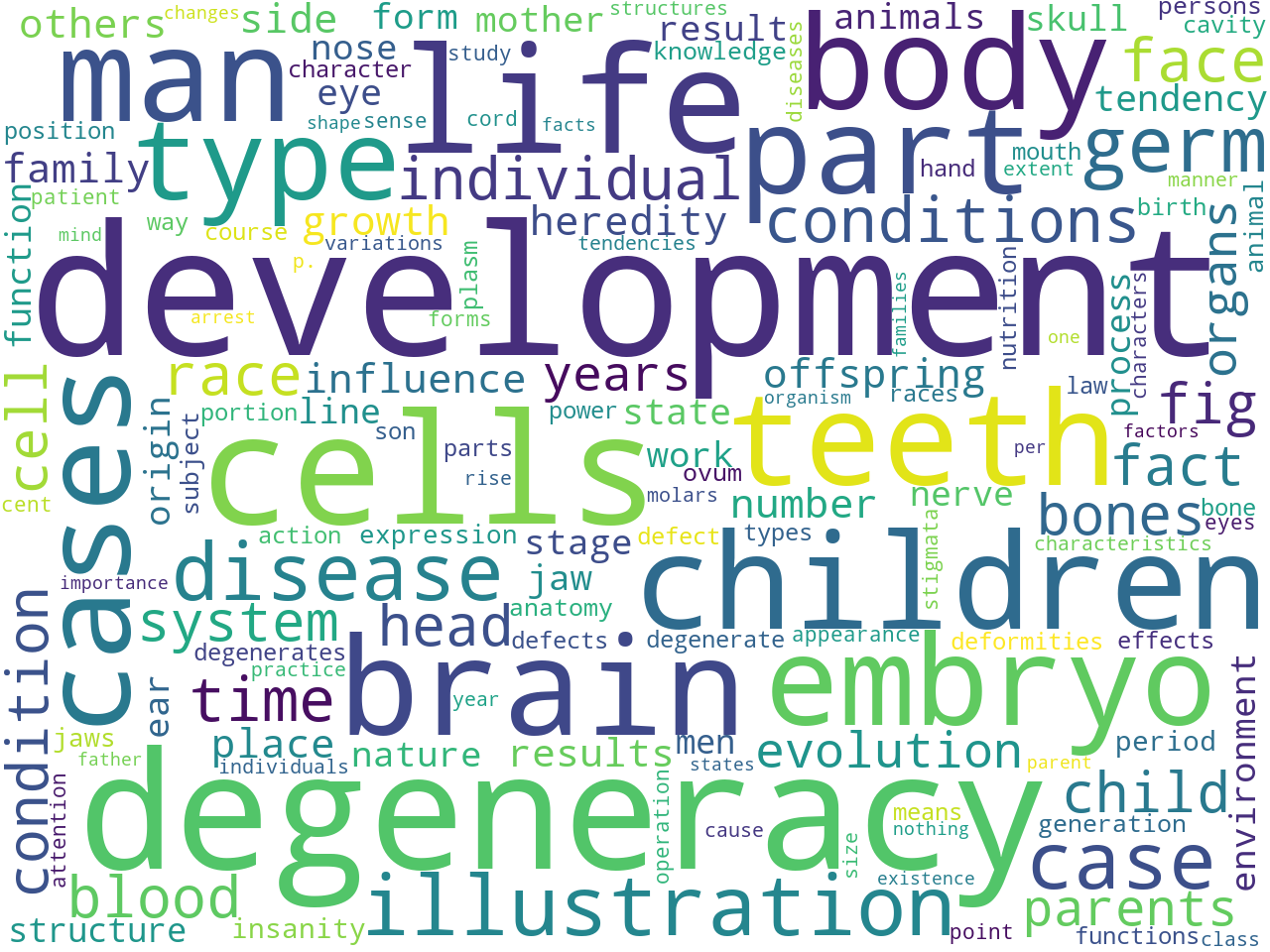
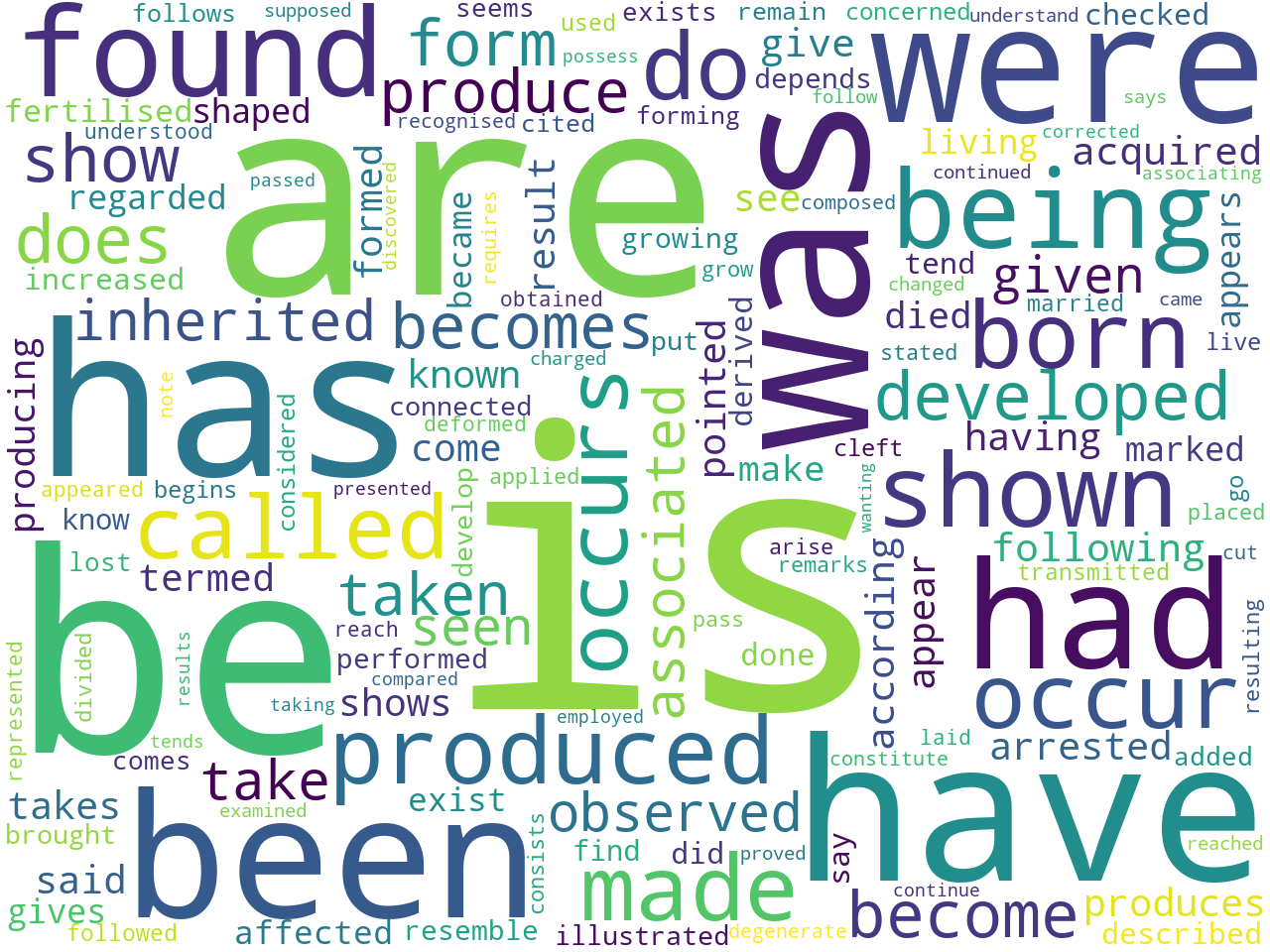
Proper Nouns
An extraction of proper nouns helps you determine the names of people and places in your study carrel.
_, fig, |, c., journal, dr., medical, new, degeneracy, 6d, w., germ, j., chicago, vol, kiernan, h., american, b., de, g., e., york, states, s., morel, english, degenerate, f., united, t., spitzka, disease, london, england, mental, life, insanity, cloth, st., ., darwin, brain, weismann, professor, p., man, m., school, nervous
An analysis of personal pronouns enables you to answer at least two questions: 1) "What, if any, is the overall gender of my study carrel?", and 2) "To what degree are the texts in my study carrel self-centered versus inclusive?"
it, they, their, its, his, he, we, them, itself, her, themselves, him, our, she, i, my, himself, us, you, one, me, your, herself, yourself, thy, theirs, sport, ourselves, myself, mine
Below are words cloud of your study carrel's proper & personal pronouns.
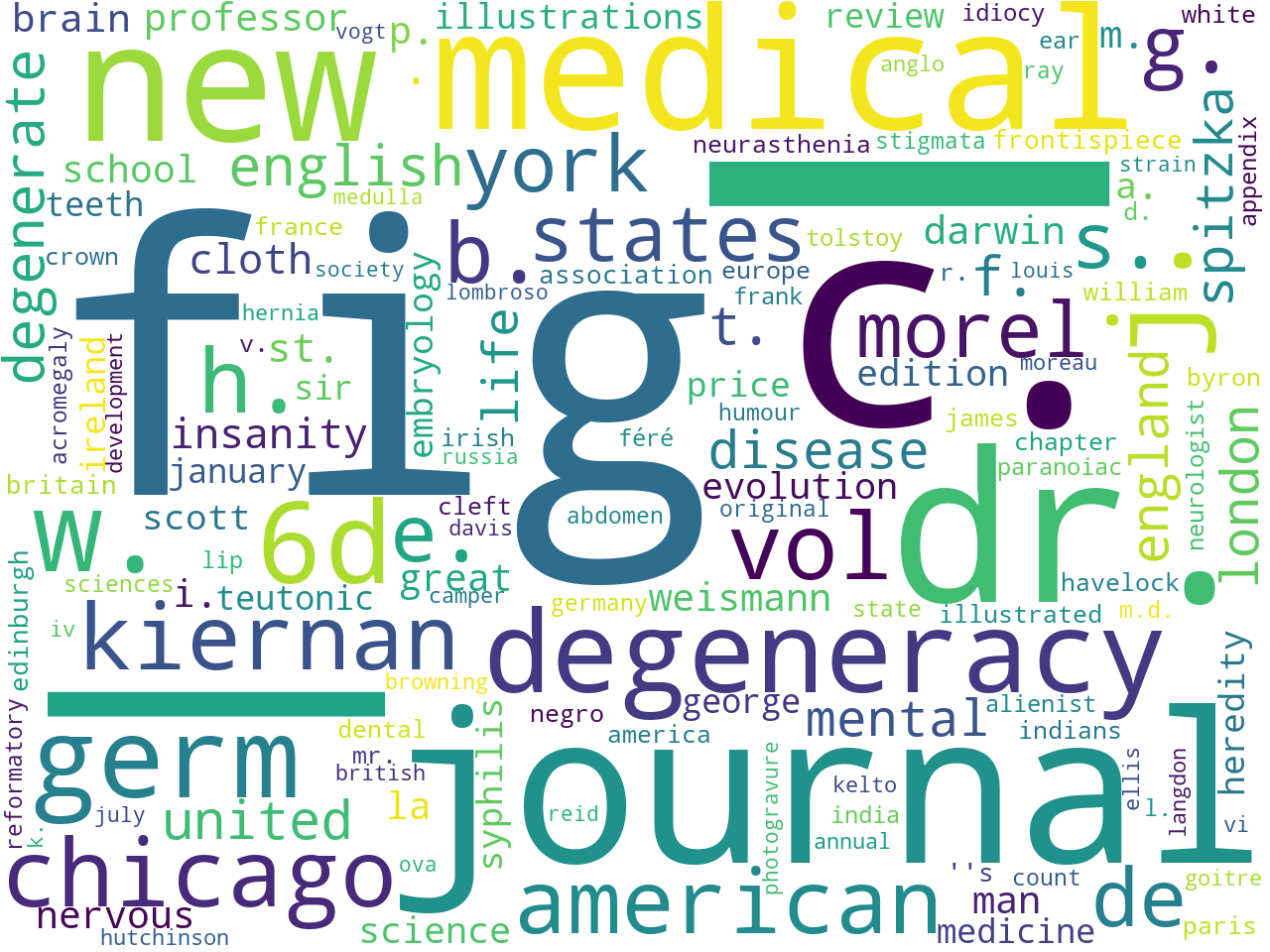
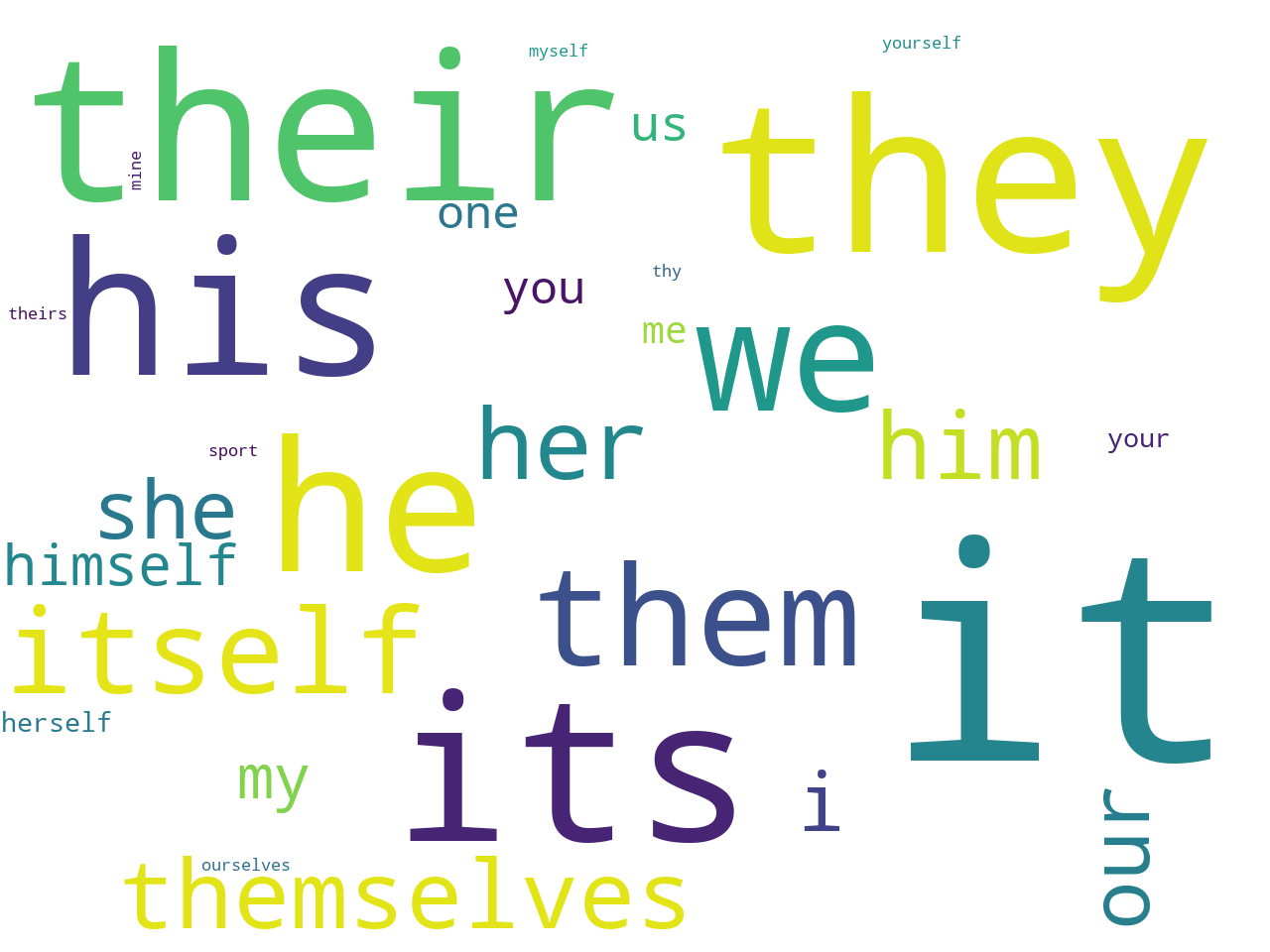
Adjectives & Verbs
Learning about a corpus's adjectives and adverbs helps you answer how questions: "How are things described and how are things done?" An analysis of adjectives and adverbs also points to a corpus's overall sentiment. "In general, is my study carrel positive or negative?"
other, such, great, same, nervous, many, first, human, certain, lower, mental, general, normal, present, large, due, similar, common, moral, more, new, important, embryonic, small, second, true, physical, different, whole, own, hereditary, higher, upper, third, little, various, single, early, much, greater, cerebral, possible, healthy, female, spinal, simple, old, last, insane, defective
not, so, very, more, only, most, often, even, as, also, well, thus, however, therefore, out, still, frequently, now, less, here, too, then, much, especially, up, sometimes, hence, far, first, never, together, long, already, nearly, almost, generally, always, later, usually, quite, down, entirely, ultimately, just, on, merely, finally, alone, about, ago
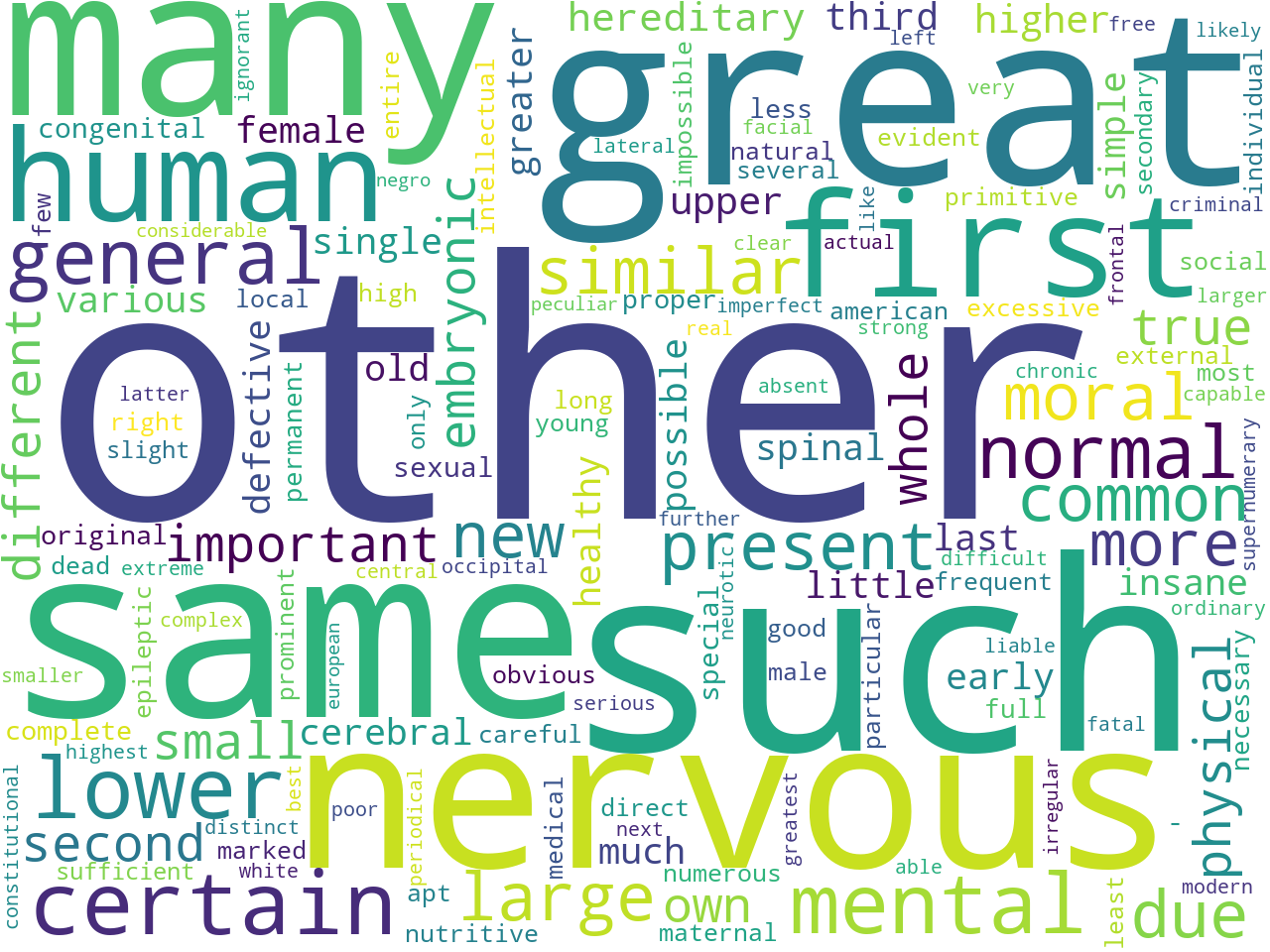
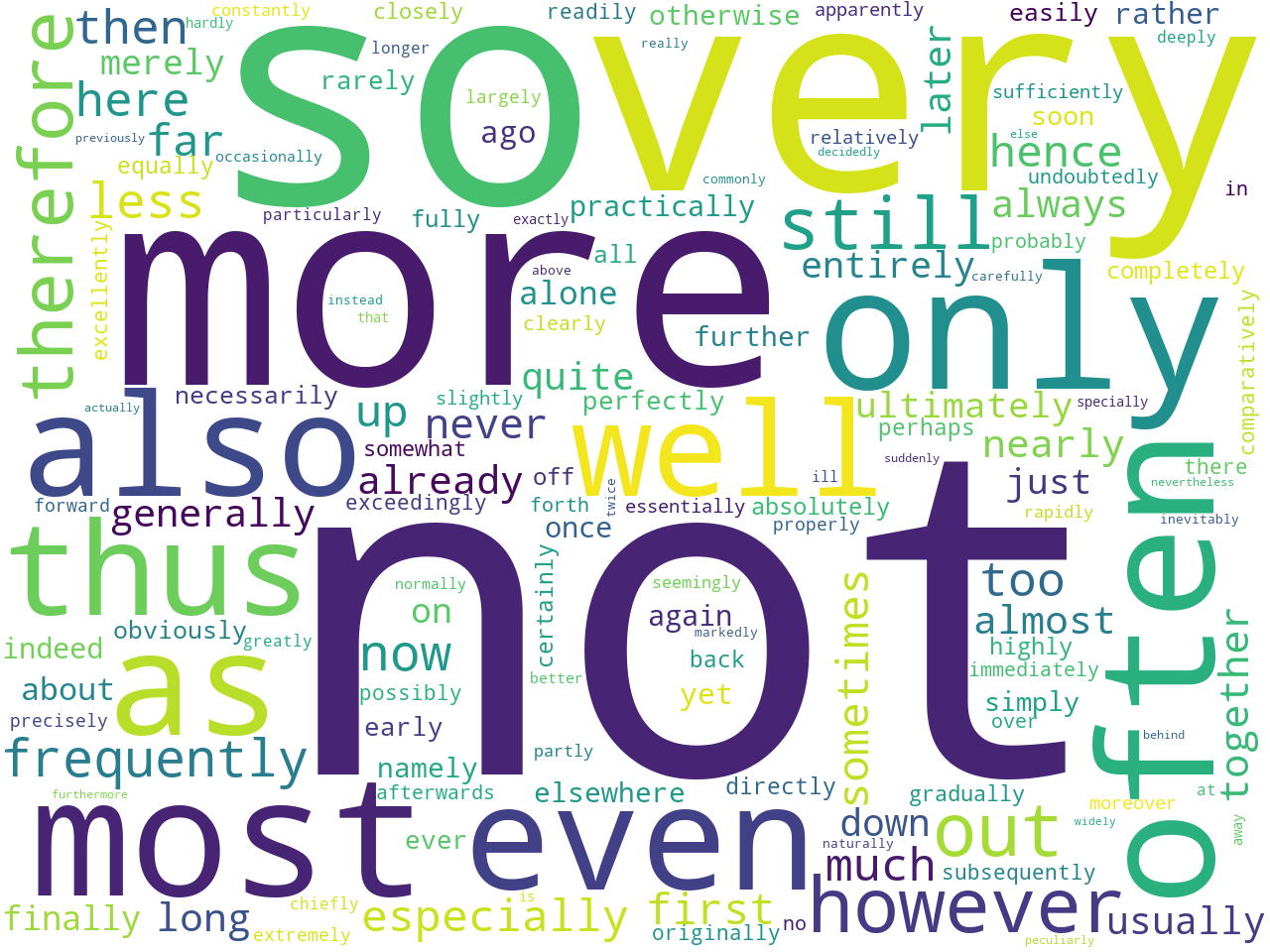
Next steps
There is much more to a study carrel than the things outlined above. Use this page's menubar to navigate and explore in more detail. There you will find additional features & functions including: ngrams, parts-of-speech, grammars, named entities, topic modeling, a simple search interface, etc.
Again, study carrels are self-contained. Download this carrel for offline viewing and use.
Thank you for using the Distant Reader.